The AMD Threadripper 2990WX 32-Core and 2950X 16-Core Review
by Dr. Ian Cutress on August 13, 2018 9:00 AM ESTHEDT Benchmarks: Web and Legacy Tests
While more the focus of low-end and small form factor systems, web-based benchmarks are notoriously difficult to standardize. Modern web browsers are frequently updated, with no recourse to disable those updates, and as such there is difficulty in keeping a common platform. The fast paced nature of browser development means that version numbers (and performance) can change from week to week. Despite this, web tests are often a good measure of user experience: a lot of what most office work is today revolves around web applications, particularly email and office apps, but also interfaces and development environments. Our web tests include some of the industry standard tests, as well as a few popular but older tests.
We have also included our legacy benchmarks in this section, representing a stack of older code for popular benchmarks.
WebXPRT 3: Modern Real-World Web Tasks, including AI
The company behind the XPRT test suites, Principled Technologies, has recently released the latest web-test, and rather than attach a year to the name have just called it ‘3’. This latest test (as we started the suite) has built upon and developed the ethos of previous tests: user interaction, office compute, graph generation, list sorting, HTML5, image manipulation, and even goes as far as some AI testing.
For our benchmark, we run the standard test which goes through the benchmark list seven times and provides a final result. We run this standard test four times, and take an average.
Users can access the WebXPRT test at http://principledtechnologies.com/benchmarkxprt/webxprt/
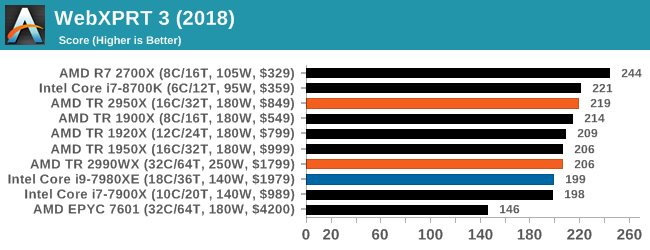
WebXPRT 2015: HTML5 and Javascript Web UX Testing
The older version of WebXPRT is the 2015 edition, which focuses on a slightly different set of web technologies and frameworks that are in use today. This is still a relevant test, especially for users interacting with not-the-latest web applications in the market, of which there are a lot. Web framework development is often very quick but with high turnover, meaning that frameworks are quickly developed, built-upon, used, and then developers move on to the next, and adjusting an application to a new framework is a difficult arduious task, especially with rapid development cycles. This leaves a lot of applications as ‘fixed-in-time’, and relevant to user experience for many years.
Similar to WebXPRT3, the main benchmark is a sectional run repeated seven times, with a final score. We repeat the whole thing four times, and average those final scores.
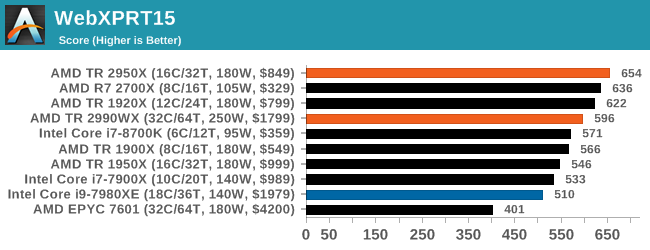
Speedometer 2: Javascript Frameworks
Our newest web test is Speedometer 2, which is a accrued test over a series of javascript frameworks to do three simple things: built a list, enable each item in the list, and remove the list. All the frameworks implement the same visual cues, but obviously apply them from different coding angles.
Our test goes through the list of frameworks, and produces a final score indicative of ‘rpm’, one of the benchmarks internal metrics. We report this final score.
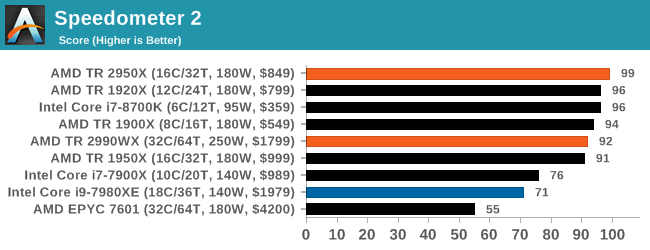
Google Octane 2.0: Core Web Compute
A popular web test for several years, but now no longer being updated, is Octane, developed by Google. Version 2.0 of the test performs the best part of two-dozen compute related tasks, such as regular expressions, cryptography, ray tracing, emulation, and Navier-Stokes physics calculations.
The test gives each sub-test a score and produces a geometric mean of the set as a final result. We run the full benchmark four times, and average the final results.
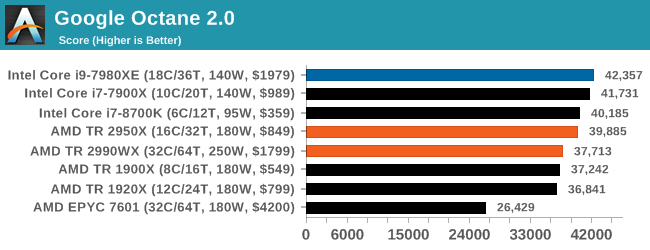
Mozilla Kraken 1.1: Core Web Compute
Even older than Octane is Kraken, this time developed by Mozilla. This is an older test that does similar computational mechanics, such as audio processing or image filtering. Kraken seems to produce a highly variable result depending on the browser version, as it is a test that is keenly optimized for.
The main benchmark runs through each of the sub-tests ten times and produces an average time to completion for each loop, given in milliseconds. We run the full benchmark four times and take an average of the time taken.
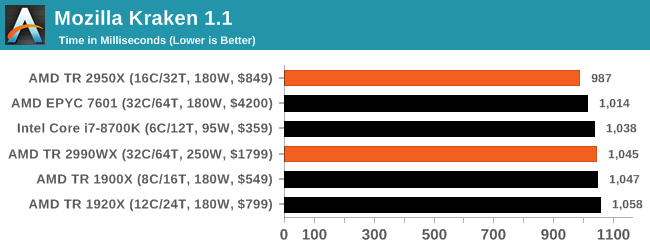
3DPM v1: Naïve Code Variant of 3DPM v2.1
The first legacy test in the suite is the first version of our 3DPM benchmark. This is the ultimate naïve version of the code, as if it was written by scientist with no knowledge of how computer hardware, compilers, or optimization works (which in fact, it was at the start). This represents a large body of scientific simulation out in the wild, where getting the answer is more important than it being fast (getting a result in 4 days is acceptable if it’s correct, rather than sending someone away for a year to learn to code and getting the result in 5 minutes).
In this version, the only real optimization was in the compiler flags (-O2, -fp:fast), compiling it in release mode, and enabling OpenMP in the main compute loops. The loops were not configured for function size, and one of the key slowdowns is false sharing in the cache. It also has long dependency chains based on the random number generation, which leads to relatively poor performance on specific compute microarchitectures.
3DPM v1 can be downloaded with our 3DPM v2 code here: 3DPMv2.1.rar (13.0 MB)
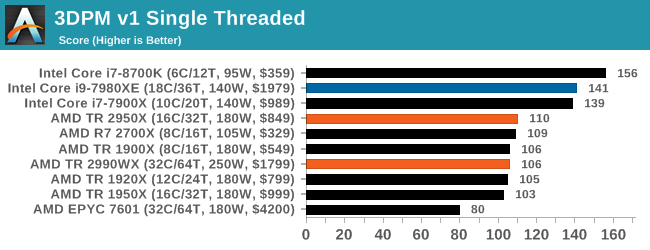
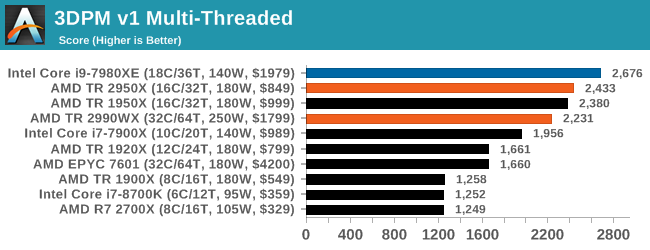
x264 HD 3.0: Older Transcode Test
This transcoding test is super old, and was used by Anand back in the day of Pentium 4 and Athlon II processors. Here a standardized 720p video is transcoded with a two-pass conversion, with the benchmark showing the frames-per-second of each pass. This benchmark is single-threaded, and between some micro-architectures we seem to actually hit an instructions-per-clock wall.
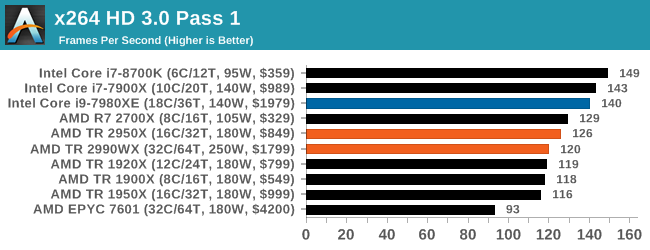











171 Comments
View All Comments
ibnmadhi - Monday, August 13, 2018 - link
It's over, Intel is finished.milkod2001 - Monday, August 13, 2018 - link
Unfortunately not even close. Intel was dominating for last decade or so. Now when AMD is back in game, many will consider AMD but most will still get Intel instead. Damage was done.It took forever to AMD to recover from being useless and will take at least 5 years till it will get some serious market share. Better late than never though...tipoo - Monday, August 13, 2018 - link
It's not imminent, but Intel sure seems set for a gradual decline. It's hard to eke out IPC wins these days so it'll be hard to shake AMD off per-core, they no longer have a massive process lead to lead on core count with their margins either, and ARM is also chipping away at the bottom.Intel will probably be a vampire that lives another hundred years, but it'll go from the 900lb gorilla to one on a decent diet.
ACE76 - Monday, August 13, 2018 - link
AMD retail sales are equal to Intel now...and they are starting to make a noticeable dent in the server market as well...it won't take 5 years for them to be on top...if Ryzen 2 delivers a 25% increase in performance, they will topple Intel in 2019/2020HStewart - Monday, August 13, 2018 - link
"AMD retail sales are equal to Intel now"Desktop maybe - but that is minimal market.
monglerbongler - Monday, August 13, 2018 - link
Pretty much this.No one really cares about workstation/prosumer/gaming PC market. Its almost certainly the smallest measurable segment of the industry.
As far as these companies' business models are concerned:
Data center/server/cluster > OEM consumer (dell, hp, microsoft, apple, asus, toshiba, etc.) > random categories like industrial or compact PCs used in hospitals and places like that > Workstation/prosumer/gaming
AMD's entire strategy is to desperately push as hard as they can into the bulwark of Intel's cloud/server/data center dominance.
Though, to be completely honest, for that segment they really only offer pure core count and PCIe as benefits. Sure they have lots of memory channels, but server/data center and cluster are already moving toward the future of storage/memory fusion (eg Optane), so that entire traditional design may start to change radically soon.
All important: Performance per unit of area inside of a box, and performance per watt? Not the greatest.
That is exceptionally important for small companies that buy cooling from the power grid (air conditioning). If you are a big company in Washington and buy your cooling via river water, you might have to invest in upgrades to your cooling system.
Beyond all that the Epyc chips are so freaking massive that they can literally restrict the ability to design 2 slot server configuration motherboards that also have to house additional compute hardware (eg GPGPU or FPGA boards). I laugh at the prospect of a 4 slot epyc motherboard. The thing will be the size of a goddamn desk. Literally a "desktop" sized motherboard.
If you cant figure it out, its obvious:
Everything except for the last category involves massive years-spanning contracts for massive orders of hundreds of thousands or millions of individual components.
You can't bet hundreds of millions or billions in R&D, plus the years-spanning billion dollar contracts with Global Foundries (AMD) or the tooling required to upgrade and maintain equipment (Intel) on the vagaries of consumers, small businesses that make workstations to order, that small fraction of people who buy workstations from OEMs, etc.
Even if you go to a place like Pixar studios or a game developer, most of the actual physical computers inside are regular, bone standard, consumer-level hardware PCs, not workstation level equipment. There certainly ARE workstations, but they are a minority of the capital equipment inside such places.
Ultimately that is why, despite all the press, despite sending out expensive test samples to Anandtech, despite flashy powerpoint presentations given by arbitrary VPs of engineering or CEOs, all of the workstation/Prosumer/gaming stuff is just low-binned server equipment.
because those are really the only 2 categories of products they make;
pure consumer, pure workstation. Everything else is just partially enabled/disabled variations on those 2 flavors.
Icehawk - Monday, August 13, 2018 - link
I was looking at some new boxes for work and our main vendors offer little if anything AMD either for server roles or desktop. Even if they did it's an uphill battle to push a "2nd tier" vendor (AMD is not but are perceived that way by some) to management.PixyMisa - Tuesday, August 14, 2018 - link
There aren't any 4-socket EPYC servers because the interconnect only allows for two sockets. The fact that it might be difficult to build such servers is irrelevant because it's impossible.leexgx - Thursday, August 16, 2018 - link
is more then 2 sockets needed when you have so many cores to play withRelic74 - Wednesday, August 29, 2018 - link
Actually there are, kind of, supermicro for example has created a 4 node server for the Epyc. Basically it's 4 computers in one server case but the performance is equal to that if not better than that of a hardware 4 socket server. Cool stuff, you should check it out. In fact, I think this is the way of the future and multi socket systems are on their way out as this solution provides more control over what CPU. As well as what the individual cores are doing and provides better power management as you can shut down individual nodes or put them in stand by where as server with 4 sockets/CPU's is basically always on.There is a really great white paper on the subject that came out of AMD, where the stated that they looked into creating a 4 socket CPU and motherboard capable of handling all of the PCI lanes needed, however it didn't make any sense for them to do so as there weren't any performance gains over the node solution.
In fact I believe we will see a resurrection of blade systems using AMD CPU's, especially now with all of the improvements that have been made with multi node cluster computing over the last few years.